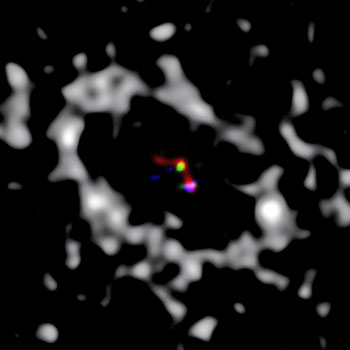
A composite image (with the central star removed) shows a greyscale millimeter image of a transition disk, with interior regions of Hα at 656 nm (blue), infrared radiation at 2.18 µm (green) and another band of infrared at 3.8 µm (red). [Image: Stephanie Sallum]
In the past two decades, astronomers have confirmed the existence of nearly 2,000 exoplanets orbiting faraway stars using indirect observational techniques, but only about ten of these exoplanets have actually been directly imaged. Of those, all were well-formed “adult” planets. Now, an international team of astronomers led by a group at the University of Arizona (UA; Tucson, Ariz., USA) has reported the first direct observations of accretion into protoplanets—planets in the process of forming—around LkCa15, a young star 450 light-years away from Earth (Nature, doi:10.1038/nature15761).
The accretion theory of planet formation describes how a disk of leftover debris orbiting a new star clumps together, growing in mass and gravitational pull as more and more disk material is swept up. Astronomers have previously found evidence of protoplanets inside these “transition disks,” but planet accretion itself is a slow process that takes eons and occurs many light-years away around young stars, and is therefore quite difficult to observe directly.
Stephanie Sallum, a UA graduate student, and Kate Follette, a graduate of UA who is now a postdoctoral researcher at Stanford University (Palo Alto, Calif., USA), serendipitously chose to observe LkCa15 using different telescopes at different wavelengths. Sallum and UA astronomy professor Josh Eisner used the Large Binocular Telescope and its adaptive-optics system on Mount Graham in Arizona, currently the world’s largest, and a novel high-contrast imaging technique called non-redundant masking to obtain infrared images of LkCa15 at 2.16 and 3.7 µm.
Follette and UA astronomy professor Laird Close used the Magellan Telescope in Chile, which also uses adaptive optics, and a simultaneous differential imaging technique to obtain images of LkCa15 in Hα at 655.8 nm. The team believes the co-located detection of infrared and Hα indicates the generation of extremely hot gas (10,000 K) as it falls into the gravitational potential well of the accreting protoplanet.
The team hopes to continue monitoring the planet formation and disk-planet interactions to determine whether the accretion is stochastic or steady.
